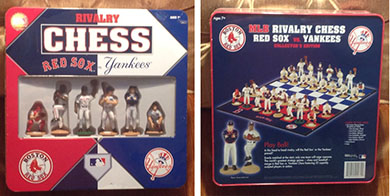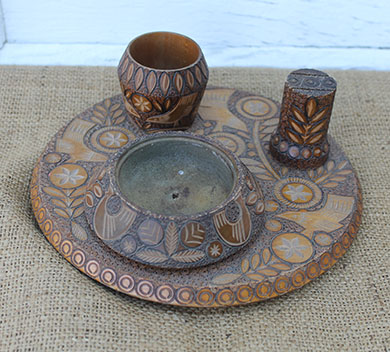 |
|
|||
 |
 |
|||
RINKER ON COLLECTIBLES — Column #1707 Copyright © Harry Rinker, LLC 2019 Questions
and Answers
QUESTION: I picked up a “Rivalry Chess” Red Sox vs. Yankees set, licensed by Major League Baseball, for $7.00 at a recent church yard-sale. The metal box still has its plastic shrink wrap. Can I make money selling this? – AC, South Jersey, NJ, Email Question 
ANSWER: The answer is yes, assuming you sell it to a Red Sox or Yankees fan who likes to play chess. I have been a Yankees fan since 1950 when my then favorite Phillies dropped four straight World Series games to the Bronx Bombers. I have been a Yankees’ fan ever since. I cannot remember the last time I played chess. Hence, although a Yankees’ fan, I am not a potential buyer. I am part of a large majority. Sports collectibles are fan focused. If the collectible does not relate to a person’s favorite team, buyer interest is greatly reduced. USAopoly produced several baseball-oriented “Rivalry” chess sets. They included Dodgers vs. Giants, Giants vs. A’s, Mariners vs. Yankees, and Red Sox vs. Yankees. The sets retailed initially around $20.00. USAopoly apparently took over the license for “Baseball Chess” manufactured by Big League Promotions in 2001. Baseball Chess was made in five different sets. The “Rivalry Chess” sets are copyrighted 2004. Its recent origin makes it fall under “Rinker’s 30 Year Rule” – For the first 30 years of anything’s life, all its value is speculative. I wonder how many of these sets were purchased and never opened, the hope being that they would increase in value in the future and then sold for a profit. As with so many products of this type, the individuals who bought them eventually became tired of holding on to them and sent them into the secondary market. As your experience demonstrates, many are sold below their initial retail cost. There are dozens of “Rivalry Chess” Red Sox vs. Yankees sets available on the internet. eBay asking prices range from $29.50 to $99.00. A set on Esty is priced at $55.20. A sale date search on WorthPoint.com reveals most sets sell through between $20.00 and $25.00. Some eBay sellers who initially listed their sets above $25.00 are cutting the prices closer to $20.00. It is not safe to assume there are buyers at this price. If there were, there would be no listings at all. In conclusion, if you are willing to undersell current listings on eBay and Esty, you likely could sell your $7.00 set for $15.00. Once $15.00 is exceeded, selling it quickly will be difficult. QUESTION: I love buying box lots. When inspecting them, I identify objects that I can sell quickly to recover my cost. The rest is profit, assuming of course I can figure out what I have. In a recent box lot, I discovered a carved wooden disk that measures 7 3/4” in diameter and has a bulbous toothpick-like cup, a cylinder with two slots, and a rimmed bowl attached. The circular and scroll decorations appear Native American touristy. My guess is that it is a desk accessory that contained an inkwell and a blotter paper holder. What to you think? – BM, Kent, OH, Email Question 
ANSWER: Guess again. It definitely is not a desk accessory. It is a tabletop smoking accessory. The bulbous toothpick-like cup held cigarettes. The cylinder with the two slots is designed for a match box. When the outside part of the box is placed into the slots, the sleeve is pushed up revealing the matches. There is enough striking surface remaining on the edges of the box to light a match. The rimmed bowl is the ashtray, albeit there most likely was a glass insert in the opening that is missing. Double check the balance of the material in the box to see if it is present. The Indian that made this smoking device more likely wore a turban than a feathered headdress. Although not marked on the bottom, I am confident it is India/Asian in origin. The set dates between 1920 and 1940. My best guess is 1930s. I considered a later date, either as a G.I. post-war occupation buy or a tourist souvenir. I rejected the idea because most post-war tabletop smoking sets include lighters and not provisions for matches. The missing glass ashtray impacts value. As it stands, it has a $8.00 to $10.00 curiosity value. Find a period amber or clear glass ashtray that fits perfectly into the wood bowl and the value jumps to $25.00 to $30.00. QUESTION: I own eight sections of wrought iron fencing that were on my grandfather’s farm. I believe they dates from the mid-to-late 1800s. Each fence section consists of four vertical elements with a rounded top on which is a shaped final. The four elements are held in place by three horizontal bars – one at the top, the middle and the bottom. I also have a gate section. A drawing of my grandfather’s farm appeared in a late 19th century county atlas. The fence is visible. I also own the mounting (carriage) step from the farm. What is the value of the wrought iron fencing and the mounting block? TT, Janesville, WI, Email Question 
ANSWER: Although your material is outside the date parameters (post-1920) for “Rinker on Collectibles,” I have chosen to answer it because many of my readers living in rural environments are very familiar with these items. When sold on the secondary market, the fencing and mounting stone are classified as architectural remnants. Architectural remnants are used for a variety of purposes: (1) restoring an old home, (2) being incorporated into new construction as accent features, (3) purchased by decorators as display or hang-on-the-wall décor, and (4) reuse. Your fencing and mounting block fall into the third and fourth categories. They have more value for decorative or reuse than any other purpose. In terms of reuse, the gate section is the key to value. A review of prices realized on WorthPoint.com suggests your fencing, if sold as a group lot, has a value between $150.00 and $200.00. Because of their local connection, the price in the greater Janesville, WI, area would increase 50 percent. Mounting blocks are sought as decorative accents for yards. Your example has a retail value between $90.00 and $115.00. QUESTION: I have loads and loads of various hand tools. Many are specialized tools for wood working and the machinist’s trade. What is the best way to dispose of them? – HS, West Chester, PA, Email Question ANSWER: Tools divide into three groups: (1) tools that can be reused, (2) tools that are collected, and (3) junk. If you have a large quantity of tools, the best approach is to find a local auctioneer who is known for achieving good prices for tools. The auctioneer may occasionally run a tool auction or have a future auction scheduled for a large estate with a large number of tools in it. If tempted to sell the tools on your own, an approach I do not recommend, divide the tools into two piles – everyday tools and specialized tools. Separate the everyday tools into two piles—those with maker’s mark and those without. Look for names like Stanley and Winchester. Ask your local reference librarian to request on interlibrary loan of a copy of Ronald Barlow’s “The Antique Tool Collector’s Guide to Value, 3rd Edition,” published by Windmill Publishing Co. in 1985. Although the values are not accurate, the book is excellent in identifying what tools have collectible value and a method to determine the more desirable tools within a type. The “Antique Trade Tools Price Guide,” published by Krause Publications in 2003, is an alternative should the librarian not be able to obtain a copy of the Barlow book. In respect to the specialized tools, contact a local technical school or community college that offers machinist courses. A young graduate just getting started might welcome the opportunity to buy the tools as a means of saving money in his/her start up. Finally, do not get your hopes up. No matter how old the tools are, there never is as much money in old tools as most owners think. Auctioneers will likely sell the tools in large lots. Your desire is to rid yourself of the burden of owning the tools. At the moment, they have no value. “Any money is better than no money” is a hard but realistic lesson when it comes to selling stuff. Harry L. Rinker welcomes questions from readers about
collectibles, those mass-produced items from the twentieth and twenty-first centuries.
Selected letters will be answered in this column.
Harry cannot provide personal answers.
Photos and other material submitted cannot be
returned.
Send your questions to: Rinker on Collectibles, 5955 Mill
Point Court SE, Kentwood, MI 49512.
You also can e-mail your questions to
harrylrinker@aol.com.
Only e-mails containing a full name and mailing address
will be considered.
|
||||